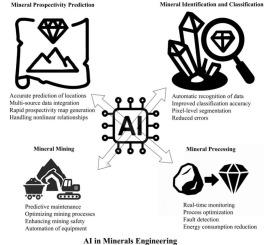Artificial intelligence transforming minerals engineering: Key trends in literature and applications
IF 5
2区 工程技术
Q1 ENGINEERING, CHEMICAL
引用次数: 0
Abstract
Artificial Intelligence (AI) is progressively reshaping the landscape of minerals engineering, driving advancements across exploration, mining, and processing. This review systematically examines the current applications of AI in these domains, highlighting its role in optimizing resource estimation, enhancing safety, and improving operational efficiency. Through a bibliometric analysis, trends, key contributors, and geographical distributions in AI-related research within minerals engineering are explored, revealing a significant rise in AI-focused studies and a global shift towards integrating these technologies. In exploration, AI techniques such as machine learning (ML) and data analytics are utilized for mineral prospectivity mapping (MPM) and anomaly detection, facilitating more precise resource identification. In mining operations, AI aids in optimizing extraction processes, predicting equipment failures, and enabling autonomous systems for increased safety. Within mineral processing, AI contributes to real-time monitoring, process optimization, and product quality improvement through advanced modeling and control systems. Despite these advancements, challenges persist, including data quality, integration complexities, and the need for interdisciplinary expertise. This review underscores AI’s transformative impact on the sector and outlines the need for continued research and collaboration to overcome existing barriers and unlock AI’s full potential in minerals engineering.

人工智能改变矿物工程:文献和应用的关键趋势
人工智能(AI)正在逐步重塑矿产工程的格局,推动勘探、采矿和加工领域的进步。本文系统地考察了人工智能在这些领域的当前应用,强调了其在优化资源估计、增强安全性和提高操作效率方面的作用。通过文献计量分析,探讨了矿物工程中人工智能相关研究的趋势、主要贡献者和地理分布,揭示了以人工智能为重点的研究的显著增加以及全球向整合这些技术的转变。在勘探中,机器学习(ML)和数据分析等人工智能技术被用于矿产远景图(MPM)和异常检测,从而促进更精确的资源识别。在采矿作业中,人工智能有助于优化开采过程,预测设备故障,并启用自主系统以提高安全性。在矿物加工中,人工智能通过先进的建模和控制系统有助于实时监控、流程优化和产品质量改进。尽管取得了这些进步,但挑战依然存在,包括数据质量、集成复杂性以及对跨学科专业知识的需求。该综述强调了人工智能对该行业的变革性影响,并概述了继续研究和合作的必要性,以克服现有障碍,释放人工智能在矿产工程中的全部潜力。
本文章由计算机程序翻译,如有差异,请以英文原文为准。
求助全文
约1分钟内获得全文
求助全文
来源期刊

Minerals Engineering
工程技术-工程:化工
CiteScore
8.70
自引率
18.80%
发文量
519
审稿时长
81 days
期刊介绍:
The purpose of the journal is to provide for the rapid publication of topical papers featuring the latest developments in the allied fields of mineral processing and extractive metallurgy. Its wide ranging coverage of research and practical (operating) topics includes physical separation methods, such as comminution, flotation concentration and dewatering, chemical methods such as bio-, hydro-, and electro-metallurgy, analytical techniques, process control, simulation and instrumentation, and mineralogical aspects of processing. Environmental issues, particularly those pertaining to sustainable development, will also be strongly covered.
 求助内容:
求助内容: 应助结果提醒方式:
应助结果提醒方式:


